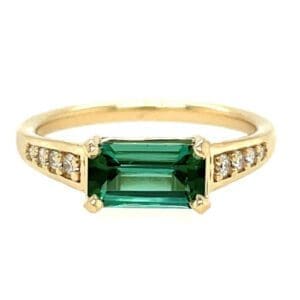The World of Maine Tourmaline: A Gem of Many Colors
When it comes to gemstones, few can rival the mesmerizing beauty and vibrant variety of Maine Tourmaline. Discovered in 1821, according to the Gemological Institute of America (GIA), this gem has captivated hearts and adorned jewelry for centuries. The story of Maine Tourmaline took a fascinating turn in 1972 when an extraordinary find in an abandoned mine on Plumbago Mountain in Newry, Maine, revealed tourmalines in every imaginable color. A literal ton of tourmaline was found during this discovery, much of which we are still purchasing from our Maine vendors today.
Our good friend, and gem expert, John Bradshaw, mining Maine Tourmaline in the 1970’s.
Notable Maine Tourmaline Mines:
Mount Mica: Located near Paris, Maine, Mount Mica is one of the oldest and most famous gem pegmatites in the United States. It has been a significant source of tourmaline since its discovery in the 1820s.
- Elbaite: The most common variety of tourmaline found here, known for its vibrant colors including pink, green, blue, and multicolored (bi-color or tri-color) specimens.
Newry: This area is known for producing high-quality tourmaline. The Newry mines, particularly the Dunton Mine, have yielded some of the most spectacular specimens.
- Elbaite: This mine is famous for its stunning watermelon tourmaline, which has a pink center surrounded by a green rind. It also produces other colors such as blue, green, and pink.
- Liddicoatite: Though less common, this variety can also be found and is known for its complex and often colorful zoned crystals.
Bingham: Mines in the Bingham area have also produced tourmaline, among other minerals.
- Elbaite: The most common variety of tourmaline found here, known for its vibrant colors including pink, green, blue, and multicolored (bi-color or tri-color) specimens.
Oxford County: This county includes several towns like Buckfield, Hebron, and Greenwood, where tourmaline has been found in various pegmatite deposits.
- Elbaite: Various pegmatites throughout Oxford County produce a range of elbaite colors including pink, green, blue, and multicolored crystals.
- Schorl: Black tourmaline (schorl) is also commonly found in the pegmatites of Oxford County.
These locations are part of the larger pegmatite belt in western Maine, which is renowned for its mineral diversity and abundance.
John Bradshaw at Mount Mica.
Maine Tourmaline is shrouded in stories and legends about its discovery. In its early days, tourmaline was often mistaken for other precious gems such as emeralds, sapphires, and rubies. However, as gemologists began to study this unique mineral, they recognized it as a distinct gem with its own identity and allure. Today, tourmaline is celebrated for its dazzling spectrum of colors, more than any other gemstone. It can also come in a combination of two or three colors which are called bi-color or tricolor and sometimes called “parti” colored.
The Rainbow Gemstone
The magnificent variety of color of Maine Tourmalines. Photo credit: Robert Weldon/GIA
Tourmaline comes in a breathtaking array of colors, each with its own name and charm. Let’s explore some of the most captivating hues:
- Red and Pink: Known as Rubellite, these colors can be the most expensive and are highly prized for their vivid, rich tones.
- Blue: Indicolite, the blue variety of tourmaline, is cherished for its serene and deep hues.
- Green: Ranging from mint to apple green, this popular color is highly sought after. Each shade of green tourmaline offers a unique, refreshing beauty.
- Black: Schorl, the black tourmaline, is less commonly set in jewelry due to its tendency to have cracks, though it finds a unique use in technology such as hair dryers.
- Watermelon: This fascinating variety showcases multiple colors, resembling a slice of watermelon with its pink center and green rind. A good example of the bi-color, or tri-color, version.
- Cat’s Eye: A rare form of tourmaline that exhibits a cat’s eye effect, adding to its allure.
The Durability and Care of Tourmaline
Tourmaline ranks 7 to 7.5 on the Mohs hardness scale, making it durable enough for everyday wear yet requiring care. Its toughness is fair, and it often contains inclusions like bubbles and fissures, which can help identify genuine stones. While there are no synthetic tourmalines, imitations made of glass exist but lack the natural beauty of the real gem.
To maintain their beauty, tourmalines should be cleaned with warm soapy water. Avoid using ultrasonic cleaners, as the inclusions can make the stones vulnerable to damage. Some tourmalines are heat-treated to enhance their color; these treated stones may fade when exposed to high heat or intense light, so handle them with care.
A Gemstone of Celebration and Belief
Pink tourmaline, the birthstone for October, is also a traditional gift for the 8th wedding anniversary. It is believed to bring happiness, self-confidence, and wisdom to its wearer—qualities that everyone can appreciate. Whether given as a gift or worn for personal enjoyment, tourmaline’s vibrant colors and storied history make it a gemstone to treasure.
Embrace the Magic of Tourmaline
From its rich history to its stunning array of colors, Maine Tourmaline continues to enchant gem lovers around the world. Whether you’re drawn to the fiery red Rubellite or the serene blue Indicolite, there’s a tourmaline for everyone. Add a touch of Maine’s gemological legacy to your collection and let the magic of tourmaline enhance your life with its beauty and charm.
.






